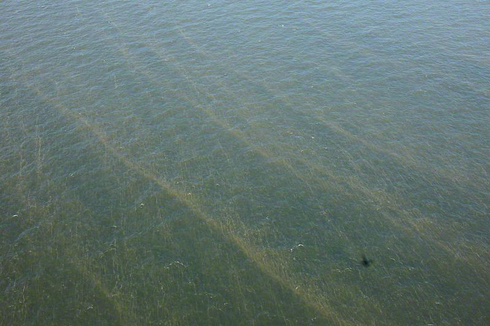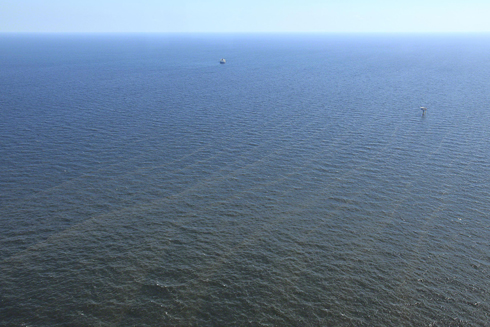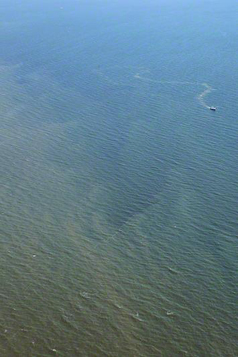On Saturday, October 23, Truthout spotted what appeared to be massive areas of weathered oil floating near Louisiana's fragile marshlands in both East and West Bays along the Mississippi River Delta. In addition, at least two more oil leaks were spotted near oil and gas platforms along Louisiana's embattled coastline.
Four days prior, federal on-scene cleanup coordinator for the BP oil disaster, Coast Guard Rear Adm. Paul Zukunft, declared there was little recoverable surface oil in the Gulf of Mexico.
Miles-long strands of what appears to be weathered BP oil in bays near Southwest Pass, Louisiana. (Photo: Erika Blumenfeld)
Another view of miles-long strands of what appears to be weathered BP oil in bays near Southwest Pass, Louisiana. (Photo: Erika Blumenfeld)
Both Bays cover an area of roughly 70 square miles of open water that surround Southwest Pass, the main shipping channel of the Mississippi River. While East Bay remains closed for fishing, West Bay was currently open for fishing when Truthout spotted the substance on October 23, despite the fact that the day before a BP oil cleanup crew had reported oil in West Bay to a local newspaper.
(Shrimper trawling in oil, in West Bay, Louisiana. (Photo: Erika Blumenfeld)
"They are literally shrimping in oil," Jonathan
Henderson, the coastal resiliency organizer of the environmental group
the Gulf Restoration Network, who was with Truthout on the flight,
exclaimed while our plane flew near the fishermen.
"Our tests continue to reveal seafood from the reopened areas is safe to
eat," Jane Lubchenco, US National Oceanic and Atmospheric
Administration (NOAA) administrator, told reporters while NOAA recently opened more federal waters in the Gulf.
The day before Truthout's oil sighting, NOAA had
reopened more of the previously closed fishing areas, bringing to 96
percent the federal waters now deemed safe for fishing.
The waters in East and West Bay are under the jurisdiction of Louisiana's Department of Wildlife and Fisheries (LDWF) , while waters further from the coast are under federal jurisdiction. LDWF does receive input, however, from NOAA.
Earlier in the same day, Truthout spotted the substance. A spotter pilot for LDWF had flown over the same area and told Southern Seaplanes there was no oil.
"He is the spotter for LDWF and saw that bay, and it is still open," Henderson told Truthout. "He should have closed the Bay for fishing. So now you can see how sophisticated they are in tracking this. Either this guy is completely incompetent, or has an agenda to keep as much of Louisiana's waters open for fishing as he can, whether there is oil or not. I don't see how he could have flown down there today and not seen it. It's criminal."
When Truthout called the LDWF requesting to talk with the LDWF oil spotter, Truthout was told, "that person is not available to comment."
The LDWF web site has a number to call in order to report oil sightings. When Truthout called that number, the call was answered by a BP response call center.
The only federal waters of the Gulf that have yet to be reopened are a 9,444-square-mile area directly around the BP wellhead where the Deepwater Horizon exploded, burned and sank to the bottom of the Gulf.
On October 23, the Coast Guard claimed that the substance floating in the miles-wide areas of West Bay appeared to be "an algal bloom."
(Note: You can view every article as one long page if you sign up as an Advocate Member, or higher).







